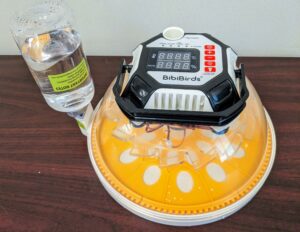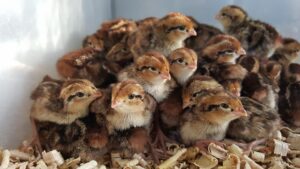4-H Embryology in the Classroom
go.ncsu.edu/readext?951457
en Español / em Português
El inglés es el idioma de control de esta página. En la medida en que haya algún conflicto entre la traducción al inglés y la traducción, el inglés prevalece.
Al hacer clic en el enlace de traducción se activa un servicio de traducción gratuito para convertir la página al español. Al igual que con cualquier traducción por Internet, la conversión no es sensible al contexto y puede que no traduzca el texto en su significado original. NC State Extension no garantiza la exactitud del texto traducido. Por favor, tenga en cuenta que algunas aplicaciones y/o servicios pueden no funcionar como se espera cuando se traducen.
Português
Inglês é o idioma de controle desta página. Na medida que haja algum conflito entre o texto original em Inglês e a tradução, o Inglês prevalece.
Ao clicar no link de tradução, um serviço gratuito de tradução será ativado para converter a página para o Português. Como em qualquer tradução pela internet, a conversão não é sensivel ao contexto e pode não ocorrer a tradução para o significado orginal. O serviço de Extensão da Carolina do Norte (NC State Extension) não garante a exatidão do texto traduzido. Por favor, observe que algumas funções ou serviços podem não funcionar como esperado após a tradução.
English
English is the controlling language of this page. To the extent there is any conflict between the English text and the translation, English controls.
Clicking on the translation link activates a free translation service to convert the page to Spanish. As with any Internet translation, the conversion is not context-sensitive and may not translate the text to its original meaning. NC State Extension does not guarantee the accuracy of the translated text. Please note that some applications and/or services may not function as expected when translated.
Collapse ▲Gaston County Embryology Program
The 4-H Embryology Program is a hands-on science project that aligns with the second-grade standard course of study for North Carolina. The program goal is to teach the stages of quail development and growth from early fertilization through hatching. There is no cost to participate in the program, but training is required, and supplies are limited. Please note: Due to the limited number of supplies, only Gaston County schools are eligible to participate.
For more information, contact Gaston County Youth and Families Program Lead: Jonette Mungo, Jonette.Mungo@gastongov.com or 704.922.2111.
Teachers can register for the project here using this link: https://forms.gle/c7X7W1a6SjSedvNF9
Fall 2025 Dates to Remember
- Project Registration for teachers: August 5- September 3
- Mandatory teacher training (2 options) and incubator pick-up: September 17th or 18th
- Receive fertilized eggs: September 30th
- Set eggs in incubator: September 30th
- Return hatched chicks to the Cooperative Extension Office: October 22nd -24th (9:00 a.m. – 4:00 p.m.)
The 4-H Embryology Program is designed to provide educators with background information and exciting experiential life science activities for use in the classroom. Each activity is designed to be grade-level appropriate and has been correlated to the U.S. National Science Education Standards.
Children have a natural sense of curiosity about living things in the world around them. Building on this curiosity, students can develop an understanding of biology concepts through direct experience with living things, their life cycles, and their habitats. Many believe that students learn best through their experiences and interactions with the world. They learn by listening, observing, experimenting, and applying their knowledge to real-world situations. Each activity within this curriculum follows these steps in the experiential learning model.
Embryology programs should be conducted in collaboration with North Carolina Cooperative Extension Service and 4-H programs.
Educator Resources
If you have any other question about the embryology project, contact Christie German, Gaston County 4-H Youth Development Agent: 704.922.2126 or email: clgerman@ncsu.edu
What is the 4-H Embryology Project?
- Fundamentals of Embryology (Cleveland Co. Center)
- Introduction to Embryology (North Carolina 4-H)
- 4-H Embryology Quick Start Guide
- Chick Hatching Video
Why does Gaston County use quail eggs instead of chicken eggs?
Extension partners with local farmers who have agreed to take quail chicks upon hatching.hing.
How and where do I set up the incubator?

BibiBird Incubator Set-Up (Source: Gaston Cooperative Extension)
Incubator Set-Up:
- Do not throw away the box or Styrofoam packaging. Store the box and Styrofoam in a safe place – incubators must be returned in this box with styrofoam.
- Select a flat, stable surface for the placement of the incubator that has access to a dedicated electrical outlet.
- Avoid drafts, close contact with heating or cooling sources, and direct sunlight.
- Plug the charger into the top of the incubator and then into the wall outlet.
- Place the top clear cover onto the base. Ensure the top fits tightly all the way around the base edge.
- Fill the water bottle (purified water ONLY), close the lid then insert it into the water inlet. It will automatically refill the water.
- Power the incubator 24-36 hours before placing eggs to ensure the temperature and humidity can reach the stable level.
- The best temperature for your eggs will be 99.5 to 100 degrees Fahrenheit
- Try to keep the humidity between 40% and 55%. Just add more water or let more moisture out to stabilize the incubator.
- Remove the clear top and put the eggs in the egg shape holes in the turning tray. Suggest placing small end towards the center. NOTE: Make sure you wash your hands thoroughly before touching the eggs, to prevent clogging up the pores in the egg. Also, wash your hands after handling of the eggs.
- Replace the top and check that the top fights tightly all the way around the base edge.
- After setting the eggs and replacing the top, you can press the Egg Turning button to test if the tray rotates the eggs.
- Eggs will need to be turned at least 3 times per day.
- You can mark one side of the eggs with an “X” and the other side with an “O” to confirm the egg turner is working and to keep track of how many times each day the eggs are turning.
- Set the Day counter.
- Quail take 23 days to hatch.
- Use a 3 second press on the Egg Candler button to adjust the hatching days.
- Press “+” or “-” to adjust after day count panel flickers.
- After you’ve had your eggs in the incubator for several days, you will be able to candle your eggs.
- Take an egg out of the incubator and place the large side of the egg in the candling zone, press the Egg Candler button to observe the interior of the egg.
- Three days before your eggs are to hatch, its time to go into lockdown. To avoid harming the chicks, the Egg Turner will stop the automatic turning the last 3 days before hatch.
- Increase the humidity to a range of 65 to 70%
What should I do to prepare for eggs to hatch?
- Record daily temperatures and humidity.
- Day 21 – STOP turning eggs
- Increase relative humidity to around 70%
- Day 21 – Prep brooder box
A brooder box is a type of heated enclosure used to rear baby birds.
The use of a carboard box with pine shavings works great as a basic
brooder box.
Brooder box requirements:
- Heat source
- Feed (starter crumbles)
- Water – use a mason jar lid and fill with marbles and then water






